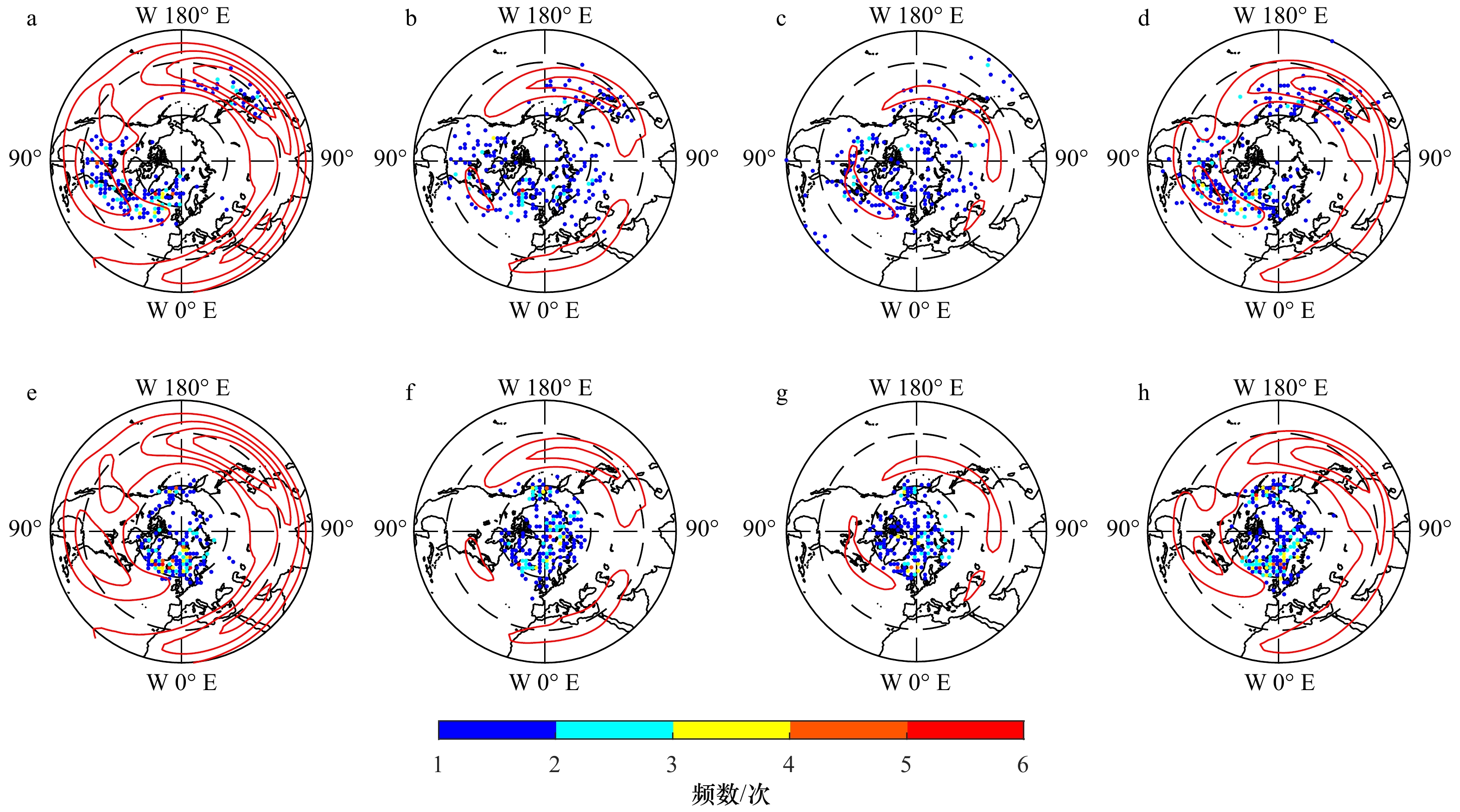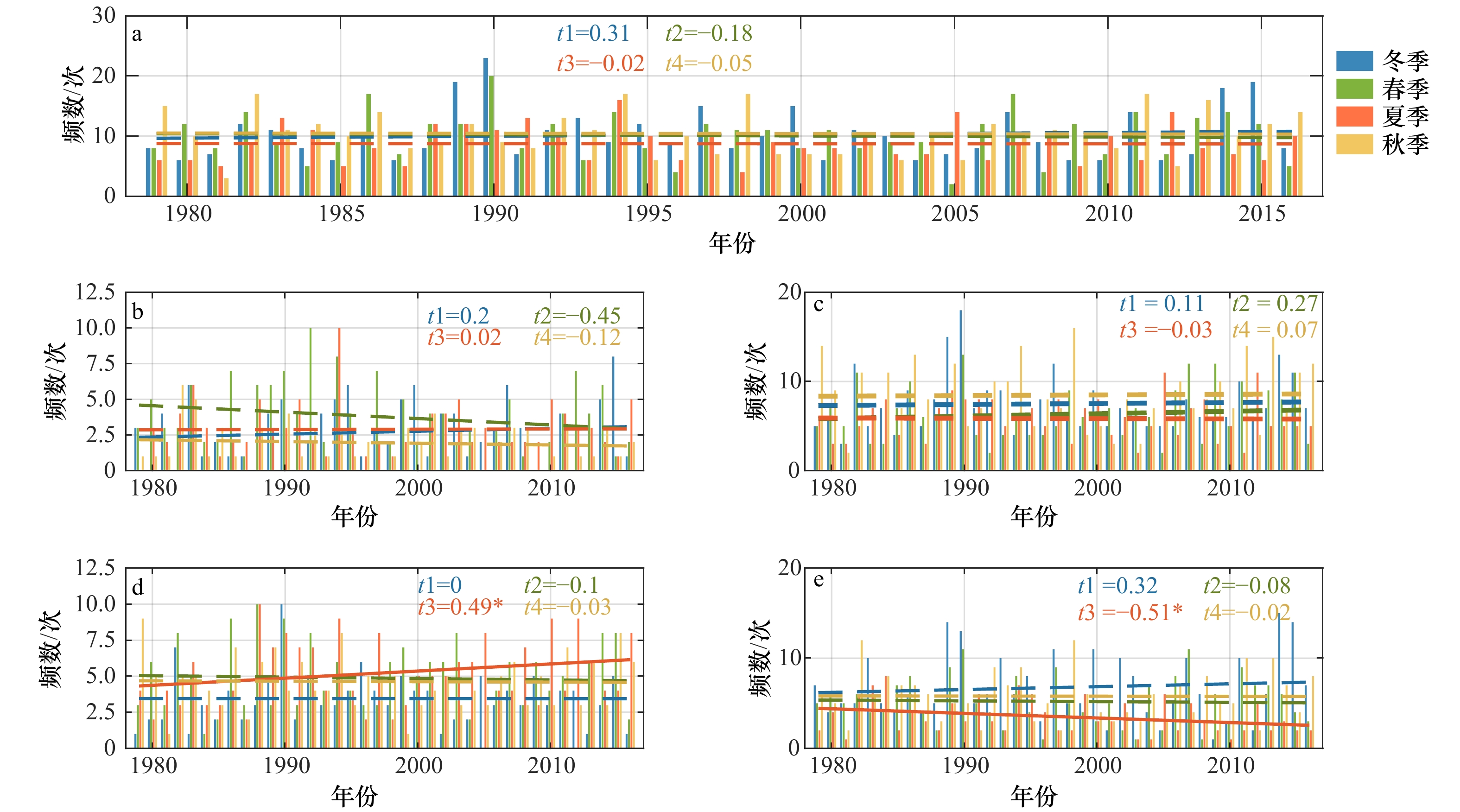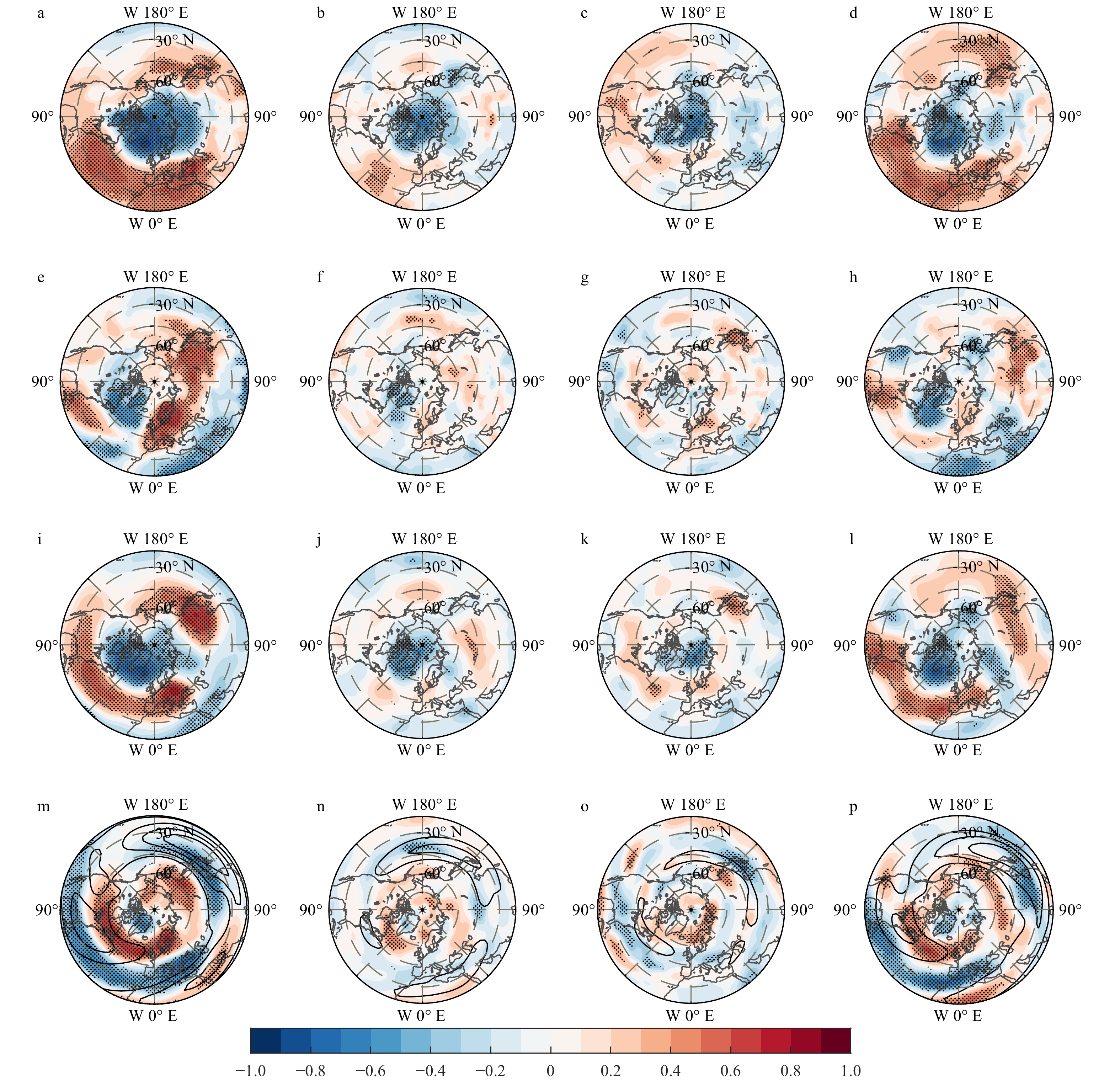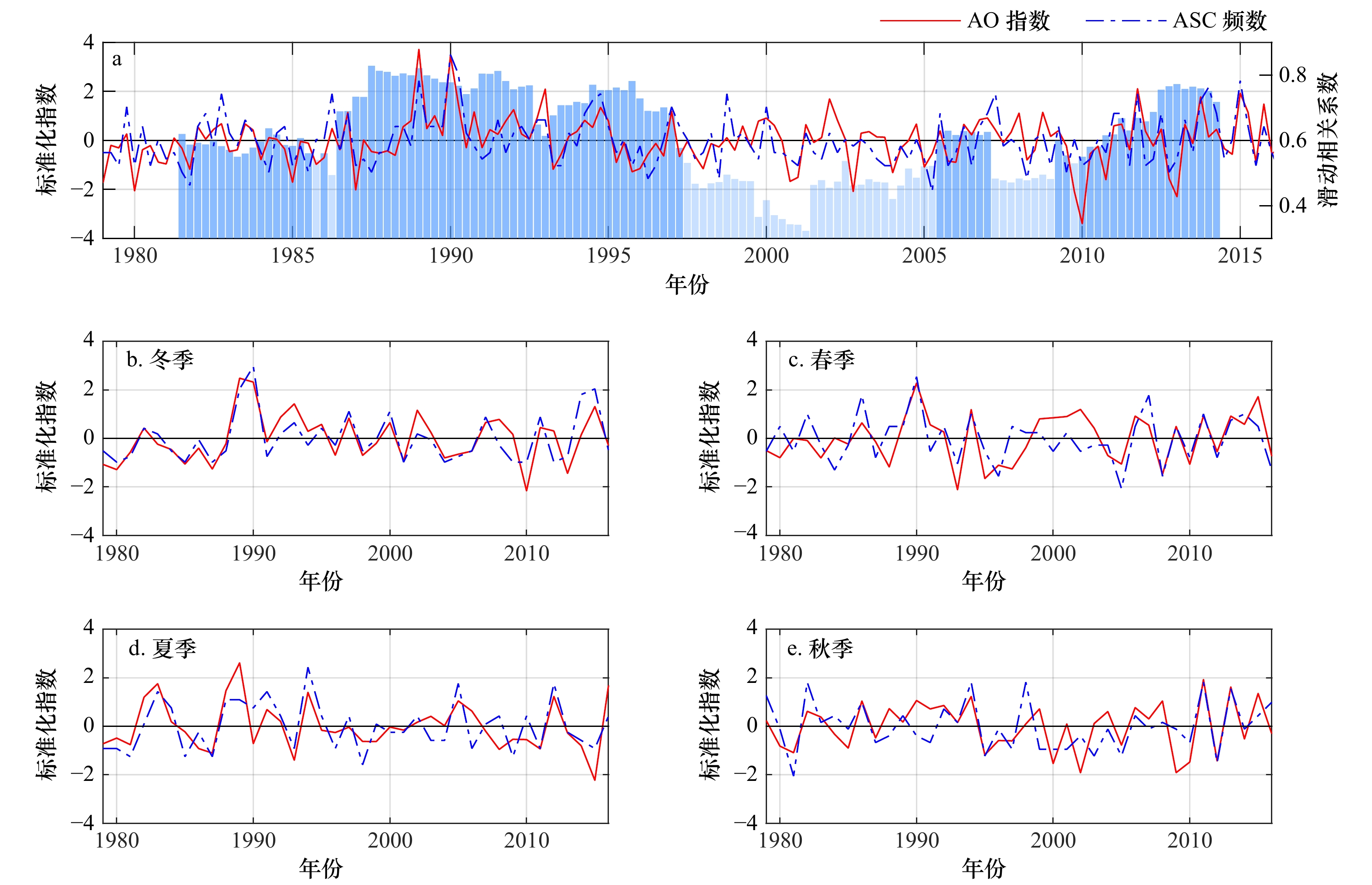Arctic super cyclone activity and its atmospheric circulation characteristics
-
摘要: 北极极端气旋过程能够反映北极气候变化特征并对北极水文气象要素的调节具有重要影响,其活动及大气环流形势特征值得关注。利用美国国家环境预报中心(National Centers for Environmental Prediction,NCEP)与美国国家大气研究中心(National Center for Atmospheric Research,NCAR)提供的逐日再分析资料定义北极超强气旋(Arctic Super Cyclone, ASC)过程,结合美国国家冰雪数据中心(National Snow and Ice Data Center, NSIDC)基于NCEP/NCAR再分析资料追踪识别的北半球气旋及特征资料,分析了ASC的活动特征及其大气环流特征。结果表明:判别ASC的北极最低气压5%阈值具有显著的冬季低夏季高的单峰型季节变化特征,冬季ASC的强度远强于夏季;ASC多从大西洋扇区经北欧海−巴伦支海−喀拉海输入到极区,也存在少部分极区原生或太平洋扇区输入;ASC多生成于两大洋急流轴或急流出口区北侧,极少数生成于大陆或中低纬度,且绝大多数在极区消亡难以回到中纬度。极区原生ASC频数占总数约1/3,整体没有显著增减趋势,但长生命史ASC频数以0.49次/(10 a)的趋势增多,表明其持续时间增长。ASC频数与北极涛动(Arctic Oscillation, AO)在冬季相关性很好,其大气环流形势回归场中极区海平面出现低压低温异常,高空极涡加深且两大洋急流偏北,中纬度急流主轴偏弱;ASC的生成发展不仅有利于AO向正位相转变,同时AO正位相下也有利于ASC活动的增强,ASC活动是AO位相变化的潜在指标。Abstract: The extreme cyclones in the Arctic can reflect the characteristics of climate change in the Arctic and have important influence on the regulation of hydrometeorological elements in the Arctic. The characteristics of their activities and atmospheric circulation situation deserve attention. Using the daily reanalysis data provided by National Centers for Environmental Prediction and the National Center for Atmospheric Research (NCEP/NCAR) defines the Arctic Super Cyclone (ASC) processes. Then analyze the activity characteristics of the ASCs and their atmospheric circulation characteristics based on the NCEP/NCAR reanalysis data of the National Snow and Ice Data Center (NSIDC). The results show that the 5% threshold of the minimum pressure in the Arctic for identifying ASCs have a significant unimodal seasonal variation characteristic that is low in winter and high in summer, which means the intensity of ASC in winter is much stronger than that in summer. Most of the ASCs are imported from the Atlantic sector to the polar region via the Nordic Sea, Barents Sea and the Kara Sea. Besides, a small part of the ASCs are imported from the original or Pacific sector. Most ASCs are generated on the north side of the jet axis or outlet area of the jet stream on two oceans. A minimal number of ASCs are generated in the continent or the middle and low latitudes. And the vast majority of ASCs disappear in the polar region and cannot return to the middle latitudes. The frequency of polar native ASC accounted for about one-third of the total, and there was no significant trend of increase or decrease overall. However, the frequency of long-life ASCs increased with a 0.49 times/decade trend, indicating their duration increased. There is a strong correlation between ASCs frequency and the Arctic Oscillation (AO) in winter. There are low-temperature and low-pressure anomalies in the polar region of the regression of the atmospheric circulation pattern. The upper polar vortex deepens and the two ocean jets turn northward, while the central axis of the mid-latitude jet stream is weak. The formation and development of ASCs are not only conducive to the transition of AO to the positive phase, but also conducive to the enhancement of ASC activity under the positive phase of AO, which is a potential indicator of AO phase change.
-
Key words:
- Arctic super cyclone /
- extreme weather process /
- Arctic Oscillation
-
图 1 北半球高纬度(50°N 以北)北极超强气旋频数分布
a. 1979–2016年北极超强气旋总频数分布,洋红色等值线表示500 hPa风暴轴平均位置;b–e. 冬季(JFM)、春季(AMJ)、夏季(JAS)和秋季(OND)北极超强气旋频数分布
Fig. 1 Frequency distribution of Arctic super cyclone at high latitudes in the Northern Hemisphere (north of 50°N)
a. The total frequency distribution of Arctic super cyclone from 1979 to 2016, the magenta contour lines indicate the average position of the 500 hPa storm track; b–e. the distribution of Arctic super cyclone frequencies in winter (JFM), spring (AMJ), summer (JAS) and autumn (OND)
图 2 1979–2016年间北极超强气旋生成(a)、消亡(b)分布位置及其与高空急流的关系
红色粗(细)等值线表示300 hPa平均纬向风大于30 m/s(20 m/s)的高空急流区域
Fig. 2 Distribution locations of Arctic super cyclone generation (a) and extinction (b), and their relationship with the upper-level jet stream
The red coarse (fine) contours indicate areas of the upper-level jet stream where the mean zonal wind at 300 hPa is greater than 30 m/s (20 m/s)
图 3 不同季节北极超强气旋生成、消亡分布位置及其与高空急流的关系
a–d. 分别为1979–2016年间冬季(JFM)、春季(AMJ)、夏季(JAS)和秋季(OND)的北极超强气旋生成位置; e–h. 分别为1979–2016年间冬季(JFM)、春季(AMJ)、夏季(JAS)和秋季(OND)的北极超强气旋消亡位置。其中红色等值线表示300 hPa平均纬向风大于20 m/s的区域
Fig. 3 Distribution of formation or extinction position of Arctic super cyclone in different seasons and their relationship with the upper-level jet stream.
a–d. The Arctic super cyclone formation positions in winter (JFM), spring (AMJ), summer (JAS) and autumn (OND) from 1979 to 2016, respectively; e–h. the Arctic super cyclone extinction positions in winter (JFM), spring (AMJ), summer (JAS) and autumn (OND) from 1979 to 2016, respectively. The red contours represent the areas where the average zonal wind at 300 hPa is greater than 20 m/s
图 4 北极超强气旋频数年代际变化特征
a. 北极超强气旋各季节频数时间序列及年代际变化趋势;b,c. 原生和外侧输入北极超强气旋频数时间序列及年代际变化趋势;d,e. 长时间(寿命3d以上)与短时间北极超强气旋频数时间序列及年代际变化趋势。 t表示频数线性趋势,单位:次/(10 a),“*”表示通过95%显著性检验
Fig. 4 The time series and decadal variation trend of the seasonal frequency of Arctic super cyclone
a. The time series and decadal variation trend of seasonal frequency of Arctic super cyclone; b, c. The time series and decadal variation trends of primary and external input Arctic super cyclone frequency; d, e. the time series and decadal variation trend of frequency of long-lived ( with the life span over three days) and short-lived cyclones. The "t" represents the linear trend of frequency, unit: time/decade. The linear trends are marked by "*" if significant at the 95%-level
图 5 北极超强气旋大气环流回归场特征
a–d. 冬季(JFM)、春季(AMJ)、夏季(JAS )和秋季(OND)北极超强气旋标准化频数序列回归到标准化海平面气压(SLP)场;e–h. 2 m气温回归场;i–l. 500 hPa位势高度回归场;m–p. 300 hPa纬向风回归场。黑色等值线表示平均纬向风;黑色打点区域表示回归系数通过95%显著性检验
Fig. 5 Regression characteristics of atmospheric circulation of Arctic super cyclone
a–d. The normalized frequency sequences of Arctic super cyclone in winter (JFM), spring (AMJ), summer (JAS) and autumn(OND) regress to the sea level pressure (SLP); e–h. 2 m temperature; i–l. 500 hPa geopotential height; m–p. 300 hPa zonal wind. The black contours show the mean zonal wind and the dotted areas indicate that the regression coefficient have passed the 95% significance test
图 6 北极涛动(AO)指数与北极超强气旋(ASC)频数的关系
a. 1979–2016年AO指数与ASC频数标准化时间序列(折线图)及其滑动相关系数(柱状图),其中深蓝色表示通过95%显著性检验;b–e. 不同季节AO指数(红色实线)与ASC频数(蓝色虚线)标准化时间序列
Fig. 6 The relationship between the Arctic Oscillation (AO) index and the Arctic super cyclone (ASC) frequency
a. The AO index and the ASC frequency normalized time series (line) and sliding correlation coefficient (bar) from 1979 to 2016, the sliding correlation coefficient are marked by dark blue if significant at the 95%-level; b-e. the AO index (red solid line) and the ASC frequency (blue dashed line) normalized time series in different season
表 1 北极(60°N以北)海平面最低气压统计特征(单位:hPa)
Tab. 1 The statistical characteristic of the lowest sea level pressure in the Arctic (north of 60°N, unit: hPa)
1月 2月 3月 4月 5月 6月 7月 8月 9月 10月 11月 12月 最大值 1 003.3 1 002.7 1 007.9 1 006.8 1 006.4 1 006.5 1 002.6 1 002.2 999.6 999.8 998.7 1 003.1 最小值 934.4 945.5 944.8 953.9 968.1 966 972.1 970.9 959.7 947.6 942.3 933.7 平均值 974.3 976.4 980.3 986.7 991.1 991.1 991.2 989.1 984.5 980.7 977.5 974.2 标准差 10 10.3 9.8 7.6 6.1 5.1 4.5 5.2 6.6 7.9 8.3 10.1 5%阈值 956.9 958.9 963.3 972.9 980 982.6 983.2 979.3 972.4 966.8 962.7 957.1 10%阈值 961.3 962.8 967.5 977.1 983.2 984.6 985.1 982.5 975.8 970 967.1 960.2 表 2 各季节北极超强气旋、常规气旋频数与同期北极涛动(AO)指数的相关系数
Tab. 2 The correlation coefficient between frequency of Arctic super cyclones/ordinary cyclone and Arctic Oscillation index in the same period
超强气旋 常规气旋 总频数 原生气旋 输入气旋 长生命气旋 短生命气旋 总频数 原生气旋 输入气旋 长生命气旋 短生命气旋 总的AO指数 0.64** 0.40** 0.48** 0.40** 0.50** 0.06 0.02 0.07 –0.07 –0.13 冬季AO指数 0.80** 0.56** 0.69** 0.51** 0.69** 0.10 –0.18 0.27 –0.05 0.13 春季AO指数 0.62** 0.24 0.58** 0.46** 0.45* –0.11 –0.05 –0.11 –0.01 –0.12 夏季AO指数 0.67** 0.57** 0.42* 0.52** 0.43* –0.35* –0.11 –0.32* –0.36* –0.13 秋季AO指数 0.58** 0.41* 0.42* 0.46** 0.46** 0.30 0.27 0.09 –0.15 0.40* 注:*和**分别表示相关系数通过90%和95%显著性检验。 -
[1] Sorteberg A, Walsh J E. Seasonal cyclone variability at 70°N and its impact on moisture transport into the Arctic[J]. Tellus A: Dynamic Meteorology and Oceanography, 2008, 60(3): 570−586. doi: 10.1111/j.1600-0870.2007.00314.x [2] Vihma T, Screen J, Tjernström M, et al. The atmospheric role in the Arctic water cycle: A review on processes, past and future changes, and their impacts[J]. Journal Geophysical Research: Biogeosicences, 2016, 121(3): 586−620. doi: 10.1002/2015JG003132 [3] Simmonds I, Keay K. Extraordinary September Arctic sea ice reductions and their relationships with storm behavior over 1979–2008[J]. Geophysical Research Letters, 2009, 36(19): L19715. doi: 10.1029/2009GL039810 [4] Zhang Jinlun, Lindsay R, Schweiger L A, et al. The impact of an intense summer cyclone on 2012 Arctic sea ice retreat[J]. Geophysical Research Letters, 2013, 40(4): 720−726. doi: 10.1002/grl.50190 [5] Zhang Xiangdong, Walsh J E, Zhang Jing, et al. Climatology and interannual variability of Arctic cyclone activity: 1948–2002[J]. Journal of Climate, 2004, 17(12): 2300−2317. doi: 10.1175/1520-0442(2004)017<2300:CAIVOA>2.0.CO;2 [6] Simmond I, Rudeva I. The great Arctic cyclone of August 2012[J]. Geophysical Research Letters, 2012, 39(23): L23709. [7] Tao Wei, Jing Zhang, Zhang Xiangdong. The role of stratosphere vortex downward intrusion in a long-lasting late-summer Arctic storm[J]. Quarterly Journal of the Royal Meteorological Society, 2017, 143(705): 1953−1966. doi: 10.1002/qj.3055 [8] Kohout A L, Williams M J M, Toyota T, et al. In situ observations of wave-induced sea ice breakup[J]. Deep–Sea Research Part II: Topical Studies in Oceanography, 2016, 131: 22−27. doi: 10.1016/j.dsr2.2015.06.010 [9] Montiel F, Squire V A. Modelling wave-induced sea ice break-up in the marginal ice zone[J]. Proceedings of the Royal Society A Mathematical Physical and Engineering Sciences, 2017, 473(2206): 20170258. doi: 10.1098/rspa.2017.0258 [10] Moore G W K, Schweiger A, Zhang J, et al. Collapse of the 2017 winter beaufort high: A response to thinning sea ice?[J]. Geophysical Research Letters, 2018, 45(6): 2860−2869. doi: 10.1002/2017GL076446 [11] Blackmon M L. A climatological spectral study of the 500 mb geopotential height of the Northern Hemisphere[J]. Journal of the Atmospheric Sciences, 1976, 33(8): 1607−1623. doi: 10.1175/1520-0469(1976)033<1607:ACSSOT>2.0.CO;2 [12] Serreze M C. Climatological aspects of cyclone development and decay in the Arctic[J]. Atmosphere-Ocean, 1995, 33(1): 1−23. doi: 10.1080/07055900.1995.9649522 [13] Serreze M C, Barrett A P. The summer cyclone maximum over the central Arctic Ocean[J]. Journal of Climate, 2008, 21(5): 1048−1065. doi: 10.1175/2007JCLI1810.1 [14] Day J J, Holland M M, Hodges K I. Seasonal differences in the response of Arctic cyclones to climate change in CESM1[J]. Climate Dynamics, 2018, 50(9): 3885−3903. [15] Wei Lixin, Qin Ting, Li Cheng. Seasonal and inter-annual variations of Arctic cyclones and their linkage with Arctic sea ice and atmospheric teleconnections[J]. Acta Oceanologica Sinica, 2017, 36(10): 1−7. doi: 10.1007/s13131-017-1117-9 [16] Sepp M, Jaagus J. Changes in the activity and tracks of Arctic cyclones[J]. Climatic Change, 2011, 105(3): 577−595. [17] Rudeva I, Gulev S K. Climatology of cyclone size characteristics and their changes during the cyclone life cycle[J]. Monthly Weather Review, 2007, 135(7): 2568−2587. doi: 10.1175/MWR3420.1 [18] Vavrus S J. Extreme Arctic cyclones in CMIP5 historical simulations[J]. Geophysical Research Letters, 2013, 40(23): 6208−6212. doi: 10.1002/2013GL058161 [19] Simmonds I, Burke C, Keay K. Arctic climate change as manifest in cyclone behavior[J]. Journal of Climate, 2008, 21(22): 5777−5796. doi: 10.1175/2008JCLI2366.1 [20] Aizawa T, Tanaka H L. Axisymmetric structure of the long lasting summer Arctic cyclones[J]. Polar Science, 2016, 10(3): 192−198. doi: 10.1016/j.polar.2016.02.002 [21] Tao Wei, Zhang Jing, Fu Yunfei, et al. Driving roles of tropospheric and stratospheric thermal anomalies in intensification and persistence of the Arctic superstorm in 2012[J]. Geophysical Research Letters, 2017, 44(19): 10017−10025. [22] Parkinson C L, Comiso J C. On the 2012 record low Arctic sea ice cover: Combined impact of preconditioning and an August storm[J]. Geophysical Research Letters, 2013, 40(7): 1356−1361. doi: 10.1002/grl.50349 [23] Petty A A, Stroeve J C, Holland P R, et al. The Arctic sea ice cover of 2016: A year of record-low highs and higher-than-expected lows[J]. The Cryosphere, 2018, 12(2): 433−452. doi: 10.5194/tc-12-433-2018 [24] Tanaka H L, Yamagami A, Takahashi S. The structure and behavior of the Arctic cyclone in summer analyzed by the JRA-25/JCDAS data[J]. Polar Science, 2012, 6(1): 55−69. doi: 10.1016/j.polar.2012.03.001 [25] Chang E K M, Guo Yanjuan, Xia Xiaoming. CMIP5 multimodel ensemble projection of storm track change under global warming[J]. Journal of Geophysical Research: Atmospheres, 2012, 117(D23): D23118. [26] Crawford A D, Serreze M C. Does the summer Arctic frontal zone influence Arctic Ocean cyclone activity?[J]. Journal of Climate, 2016, 29(13): 4977−4993. doi: 10.1175/JCLI-D-15-0755.1 [27] Hoskins B J, Hodges K I. New perspectives on the Northern Hemisphere winter storm tracks[J]. Journal of the Atmospheric Sciences, 2002, 59(6): 1041−1061. doi: 10.1175/1520-0469(2002)059<1041:NPOTNH>2.0.CO;2 [28] 黄菲, 孙治宏, 王宏. 北极高密集度冰区海冰的多时间尺度变化特征及其极端低值事件分析[J]. 中国海洋大学学报, 2021, 51(2): 1−9.Huang Fei, Sun Zhihong, Wang Hong. Multi-scale variability of sea ice concentration in the Arctic high concentration ice region and its extremely low events[J]. Periodical of Ocean University of China, 2021, 51(2): 1−9. [29] Ogi M, Yamazaki K, Wallace J M. Influence of winter and summer surface wind anomalies on summer Arctic sea ice extent[J]. Geophysical Research Letters, 2010, 37(7): L07701. [30] Ogi M, Wallace J M. The role of summer surface wind anomalies in the summer Arctic sea ice extent in 2010 and 2011[J]. Geophysical Research Letters, 2012, 39(9): L09704. [31] Rinke A, Maturilli M, Graham R M, et al. Extreme cyclone events in the Arctic: Wintertime variability and trends[J]. Environmental Research Letters, 2017, 12(9): 094006. doi: 10.1088/1748-9326/aa7def [32] Thompson D W J, Wallace J M. The Arctic oscillation signature in the wintertime geopotential height and temperature fields[J]. Geophysical Research Letters, 1998, 25(9): 1297−1300. doi: 10.1029/98GL00950 [33] Overland J E, Wang M. The Arctic climate paradox: The recent decrease of the Arctic Oscillation[J]. Geophysical Research Letters, 2005, 32(6): L06701. [34] Wallace J M. North Atlantic Oscillation/annular mode: Two paradigms-one phenomenon[J]. Quarterly Journal of the Royal Meteorological Society, 2000, 126(564): 791−805. [35] Thompson D W J, Lee S, Baldwin M P. Atmospheric processes governing the Northern Hemisphere annular mode/North Atlantic Oscillation[J]. Geophysical Monograph, 2003, 134: 81−112. [36] Benedict J J, Lee S, Feldstein S B. Synoptic view of the North Atlantic Oscillation[J]. Journal of the Atmospheric Sciences, 2004, 61(2): 121−144. doi: 10.1175/1520-0469(2004)061<0121:SVOTNA>2.0.CO;2 [37] Baldwin M P, Dunkerton T J. Stratospheric harbingers of anomalous weather regimes[J]. Science, 2001, 294(5542): 581−584. doi: 10.1126/science.1063315 -




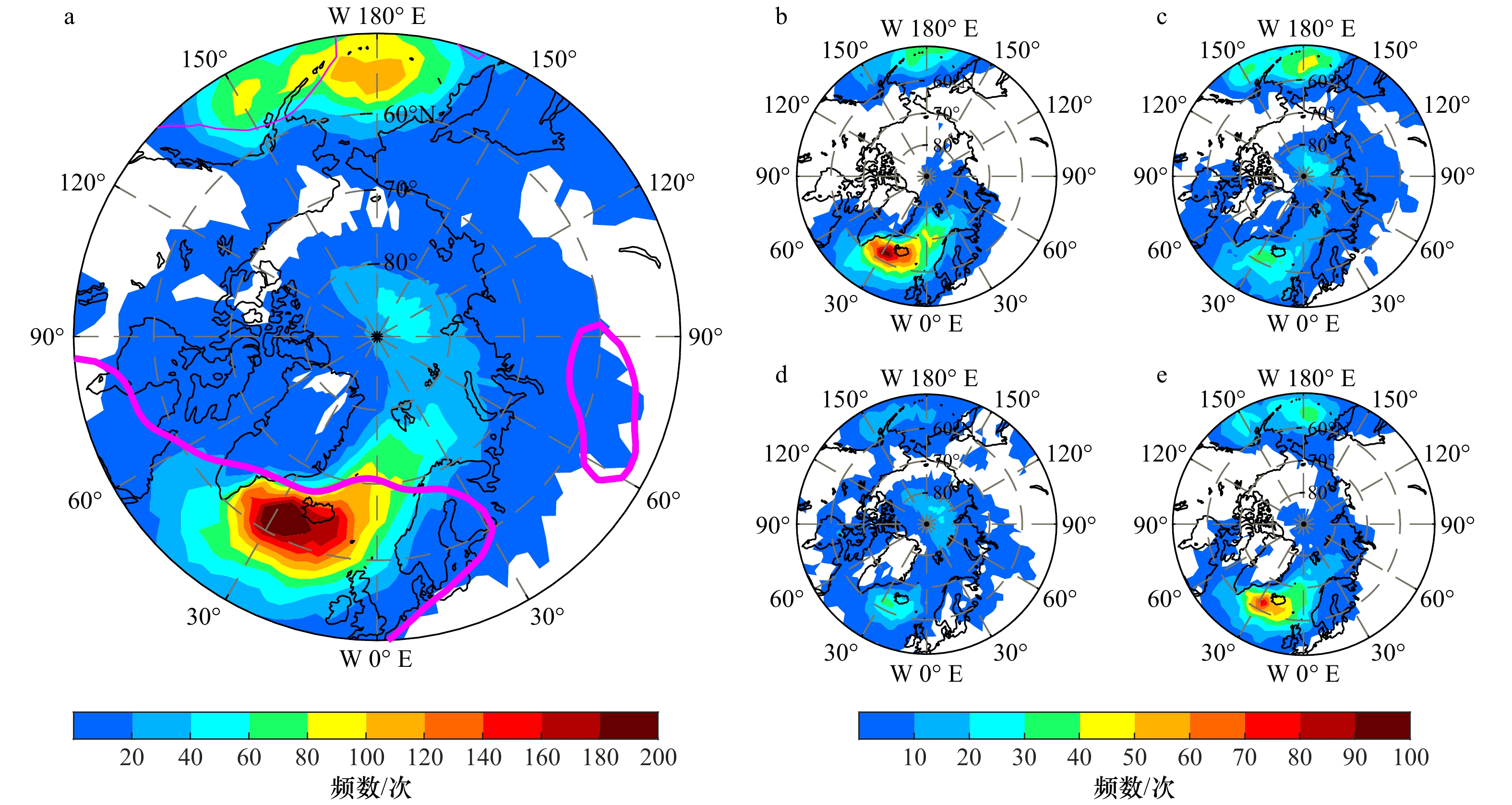
 下载:
下载:

